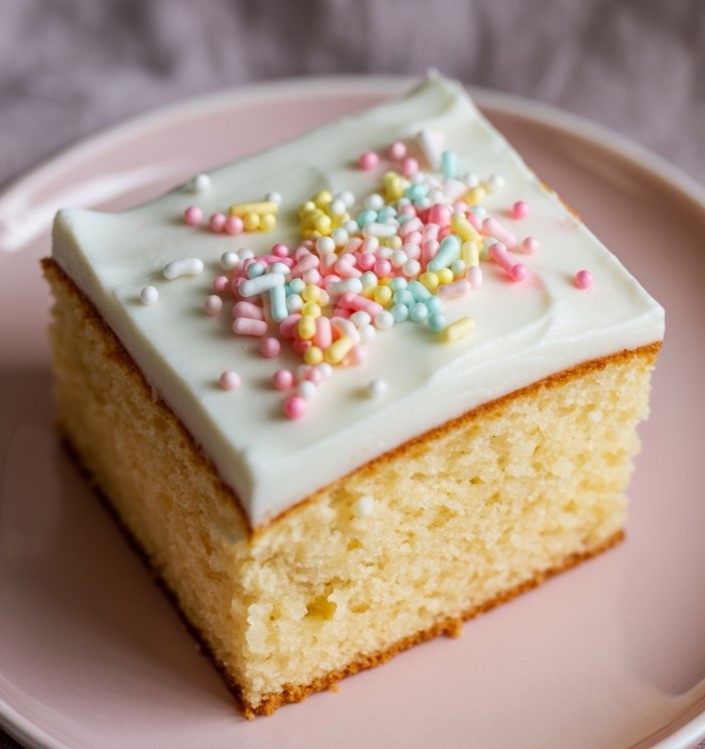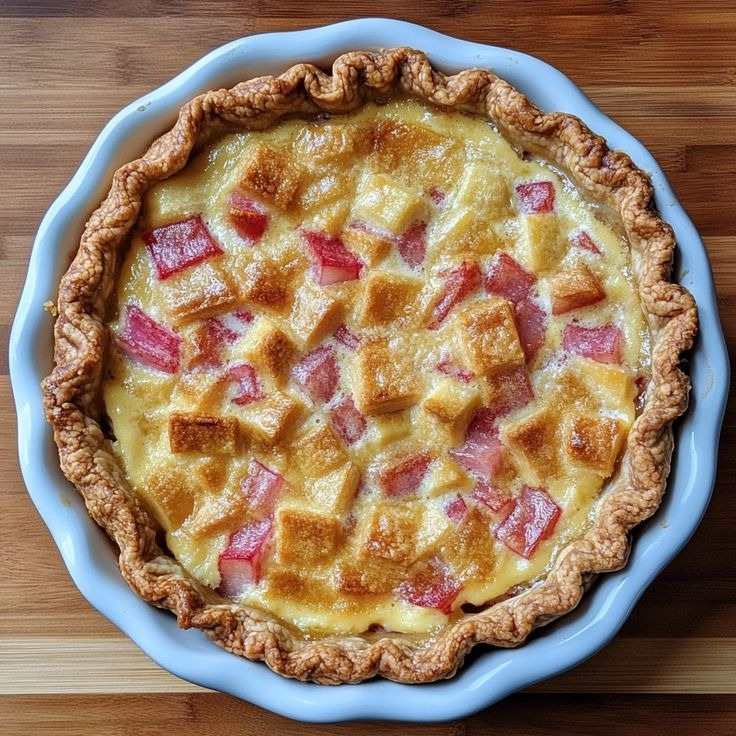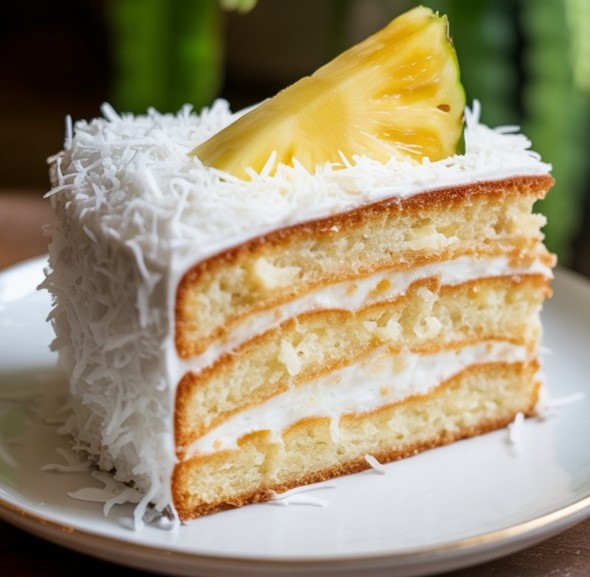On a quiet Sunday afternoon not long after retiring, I pulled out my mother’s old recipe box. Tucked between brittle newspaper clippings and handwritten cards was a faded index card labeled “Vanilla Celebration Cake.” That title always made me smile. It was the cake she made for every family occasion—birthdays, anniversaries, even the time my son graduated from college.
I still remember her standing in our small kitchen, wearing her cherry-printed apron, whipping butter with a wooden spoon before we had mixers. She didn’t follow trends or chase fancy flavors—she made food that brought people to the table. This vanilla cake was her pride. Moist, rich, and warmly fragrant, it didn’t need anything elaborate—just a good buttercream, maybe some sprinkles if we felt festive.
The first time I baked it myself, I was 19, away at university, homesick and missing her. I overbaked it and added too much vanilla, but it was still comforting. Now, years later, with her recipe a little refined through my own baking journey, I make it with the same joy.
When I shared it at my granddaughter’s school bake sale last year, a teacher came over and said, “This tastes like childhood.” That’s when I knew—it wasn’t just my memory wrapped up in those layers. It’s a flavor so timeless it speaks to everyone. So today, I’m sharing that memory with you, one moist, buttery bite at a time.

Short Description
A tender, fluffy vanilla cake that’s rich in flavor and topped with creamy buttercream frosting. Perfect for any celebration—or just because.
Key Ingredients
- 2 ½ cups all-purpose flour
- 1 cup unsalted butter, softened
- 2 cups granulated sugar
- 4 large eggs
- 1 tablespoon vanilla extract
- 1 cup whole milk
- 1 tablespoon baking powder
- ½ teaspoon salt
Tools Needed
- Two 9-inch round cake pans
- Electric mixer or hand whisk
- Mixing bowls
- Measuring cups and spoons
- Cooling rack
- Rubber spatula
- Toothpick or cake tester
Cooking Instructions
Step 1: Prep Your Oven and Pans
Preheat your oven to 350°F (175°C). Grease and flour two 9-inch round pans or line them with parchment paper. This prevents sticking and helps the cakes release cleanly after baking.
Step 2: Cream Butter and Sugar
In a large mixing bowl, beat the softened butter and sugar until pale and fluffy—about 3–4 minutes with a hand mixer. This step adds air to the batter, giving the cake a light texture.
Step 3: Add the Eggs and Vanilla
Add eggs one at a time, beating well after each. This ensures even mixing and a smooth batter. Stir in the vanilla extract for that signature aroma.
Step 4: Combine Dry Ingredients
In a separate bowl, whisk together the flour, baking powder, and salt. This evenly distributes the leavening agents and prevents lumps.
Step 5: Mix Wet and Dry Alternately
Gradually add the dry ingredients to the wet, alternating with the milk. Start and end with the dry mix. Mix on low speed and stop once just combined. The batter should be smooth but not overworked.
Step 6: Bake to Golden Perfection
Divide the batter evenly between the pans and smooth the tops. Bake for 25–30 minutes, rotating pans halfway through. The cakes are done when a toothpick inserted in the center comes out clean or with just a few moist crumbs.
Step 7: Cool and Frost
Let cakes cool in pans for 10 minutes, then transfer to a wire rack. Once fully cooled, frost with your favorite buttercream or enjoy as is.
Why You’ll Love This Recipe
– Incredibly moist with a tender crumb
– Classic flavor that pairs with any frosting
– Simple ingredients, no complicated steps
– Versatile for birthdays, showers, or a casual afternoon treat
– Perfect base for custom decorations or add-ins
Mistakes to Avoid & Solutions
Mistake 1: Overmixing the batter
Solution: Mix until ingredients are just combined. Overmixing can make the cake dense and tough.
Mistake 2: Cold ingredients
Solution: Use room temperature butter, eggs, and milk. This helps the batter mix evenly and rise properly.
Mistake 3: Uneven cake layers
Solution: Weigh the batter if needed to divide it equally between pans, and rotate pans halfway through baking.
Mistake 4: Removing cake too soon
Solution: Let cakes cool at least 10 minutes in the pan before turning out. Removing them too early risks breaking.
Mistake 5: Using old baking powder
Solution: Always check the date. Expired leavening can ruin your rise.
Serving and Pairing Suggestions
Serve with a tall glass of cold milk or hot coffee.
Top with seasonal fruits like strawberries or blueberries for a summery touch.
For parties, frost with pastel buttercream and edible flowers.
Add a scoop of vanilla or berry ice cream for a decadent dessert.
Serve family-style with toppings on the side so guests can customize.
Storage and Reheating Tips
Room Temperature: Store unfrosted cake in an airtight container for up to 2 days.
Refrigerator: Frosted cake keeps well in the fridge for up to 4–5 days. Wrap tightly or cover in a cake dome.
Freezer: Wrap layers individually in plastic and foil. Freeze up to 2 months.
Reheating: Bring to room temp or warm slices for 10–15 seconds in the microwave—just enough to soften without drying.
FAQs
1. Can I use cake flour instead of all-purpose flour?
Yes! Cake flour gives a finer, softer crumb. Use 2¾ cups of cake flour in place of 2½ cups of all-purpose.
2. What type of frosting works best with this cake?
Classic vanilla buttercream is always a hit, but cream cheese or whipped chocolate ganache also pair beautifully.
3. How do I make this cake gluten-free?
Use a 1:1 gluten-free flour blend with xanthan gum. Bake time and texture may vary slightly, so keep an eye on it.
4. Can I turn this into cupcakes?
Absolutely! Fill lined cupcake tins ⅔ full and bake at 350°F for 18–20 minutes.
5. Why is my cake dry?
It may be overbaked or overmixed. Make sure to measure flour correctly (spoon and level) and check doneness early.
Tips & Tricks
Always bring dairy and eggs to room temperature for best results.
Use clear vanilla extract for a lighter color, or pure vanilla for a deeper, richer flavor.
Level your cake layers with a serrated knife if needed for a neater finish.
Want extra moisture? Brush cake layers with a simple syrup before frosting.
Chill the cake for 15 minutes after frosting for easier slicing.
Recipe Variations
Lemon-Vanilla Cake
Swap ¼ cup of the milk for fresh lemon juice. Add 1 tablespoon lemon zest to the batter. Top with lemon buttercream or glaze for a bright twist.
Almond-Vanilla Cake
Replace ½ teaspoon of vanilla with almond extract. It adds a subtle nuttiness that pairs beautifully with raspberry preserves between layers.
Spiced Vanilla Cake
Add 1 teaspoon ground cinnamon and ¼ teaspoon nutmeg to the flour mixture. Perfect for autumn gatherings with cream cheese frosting.
Chocolate Swirl Version
Reserve ½ cup of batter and mix with 2 tablespoons cocoa powder. Swirl into the main batter before baking for a marbled effect.
Final Thoughts
This vanilla cake isn’t just a recipe—it’s a little piece of family history with every bite. It has traveled from my mother’s apron pocket to my own kitchen notebook, now shared with you. I hope you find the same comfort and connection in making it that I always have.
Whether you’re baking it for a celebration, a quiet evening at home, or just because, it’s the kind of cake that always feels like the right choice. Its warmth, its simplicity, and its versatility are exactly what home baking should be.
Over the years, I’ve learned that you don’t need to chase trends to bake something truly memorable. Sometimes, a classic vanilla cake does the job better than anything else. And once you smell it in the oven—that rich, sweet aroma wrapping around your home—you’ll understand why it never goes out of style.

Ingredients
- 2 ½ cups all-purpose flour
- 1 cup unsalted butter, softened
- 2 cups granulated sugar
- 4 large eggs
- 1 tablespoon vanilla extract
- 1 cup whole milk
- 1 tablespoon baking powder
- ½ teaspoon salt
Instructions
Step 1: Prep Your Oven and Pans
Preheat to 350°F (175°C). Grease and flour two 9-inch round pans or line with parchment for easy release.
Step 2: Cream Butter and Sugar
Beat softened butter and sugar for 3–4 minutes until light and fluffy. This adds air for a tender crumb.
Step 3: Add Eggs and Vanilla
Beat in eggs one at a time. Stir in vanilla for rich flavor and aroma.
Step 4: Combine Dry Ingredients
Whisk flour, baking powder, and salt in a separate bowl to distribute evenly.
Step 5: Mix Wet and Dry Alternately
Add dry ingredients in batches, alternating with milk. Start and end with dry. Mix until just combined—don’t overmix.
Step 6: Bake to Golden Perfection
Divide batter between pans and smooth tops. Bake 25–30 minutes, rotating halfway through. Cakes are done when a toothpick comes out clean or with moist crumbs.
Step 7: Cool and Frost
Cool cakes in pans for 10 minutes, then transfer to a wire rack. Frost when completely cool or enjoy plain.


